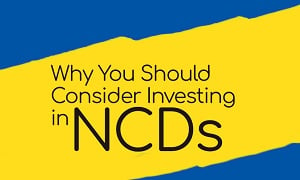NCD IPO | NCD vs FD (Fixed Deposit)

Non-Convertible Debentures (NCD's) are fixed income instruments used by companies to raise long-term capital from the public. They are known as non-convertible as these debentures cannot be converted into shares. NCD's offer a fixed rate of return to investors for a fixed period.
Here are the important points on non-convertible debentures:
- The maturity period of NCD can range from 90-days to 10 or even 30-years.
- The accumulated money through NCD is part of the capital structure of the company. In the case of equity shares, the collected amount is part of the share capital.
- With NCD issue, the liable company cannot convert this instrument to equity share as it is already specified before launch.
- As compared to convertible debentures and fixed deposits, NCD offers a higher rate of returns.
- To earn the trust of investors, the companies get the issue rated by the credit rating companies before issuing it. A higher rating denotes that the companies have the capability to pay debt on time and the default risk is lower. Similarly, the lower credit rating shows that investing in such companies have a high risk.
NCD Public Issue (NCD IPO) is the process by which a corporate raises the NCD funds through the public. The process is similar to equity initial public offer (IPO) of private limited companies. One major difference in Equity IPO and NCD public issue is the bidding of NCD stops as soon as it is fully subscribed. The allotment is based on the first come first serve basis in NCD IPO.
NCD vs Fixed Deposit (FDs)
| Parameters | NCD's | Fixed Deposits |
|---|---|---|
Issuing Entities | Corporates | Banks and Corporates |
Interest Rate | NCD's typically offer 2 to 2.5% higher returns than the bank FDs at any point in time. | |
Rate of Return (RoR) | RoR is 2 to 2.5% higher in NCD's than FDs | |
Tax Deduction at Source | NA | Applicable if gain exceeds Rs 40,000 a year. (Rs 50,000 in case of senior citizens) |
Liquidity | Low | High |
Maturity Period | 3-10 years | 7 days to 10-years |
Applicable Taxes | STCG and LTCG Tax | Interest is taxable as per your tax slab |
Major Types of NCD's
Non-Convertible Debentures are basically divided into two types; secured and unsecured NCD.
- Secured NCD
As the name suggests, you are comparatively on the safer side with secured instruments. They will provide assurance on repayment up to some extent if the company defaults. For example, Muthoot Finance LTD is planning to raise Rs. 100 crore through secured redeemable NCD's. The issue has opened on 14th Feb 2019 and is closing on 14th March 2019. As it is a secured NCD, it has a higher degree of safety on credit repayment.
- Unsecured NCD
On the other hand, unsecured debt offers a higher rate of returns than the counterpart. Unsecured NCD's involve comparatively higher risk over repayment when the company defaults. Taking the example of India Infoline Finance Limited, it has issued secured and unsecured NCD's to raise money. Based on the selection, it offers 9.50% to 10.50% coupon rates where the highest belongs to unsecured NCD with high-risk involvement.
The key difference between the secured and unsecured NCD's is that the former is supported by company assets. When the company defaults, the investor can claim money through the asset liquidation process.





0 Comments